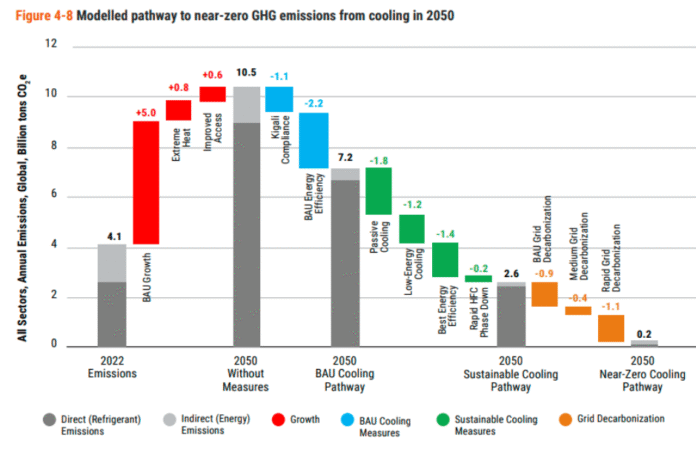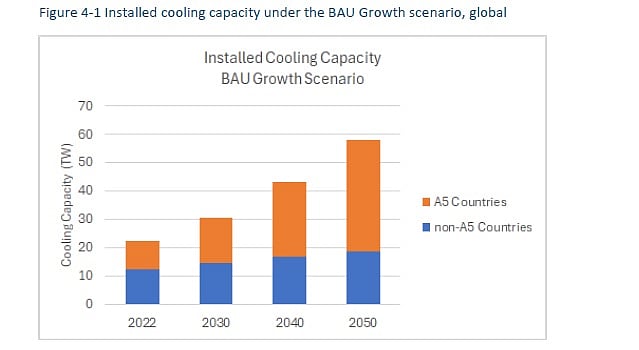Global Cooling and Climate Change Explained: Rising Demand, Risks & Solutions | The Study IAS
UNEP’s Global Cooling Watch 2025 warns cooling demand may triple by 2050. Learn why cooling needs are rising, their environmental impact, and sustainable solutions. Essential notes for UPSC preparation.
Global Cooling Demand and Climate Change: Causes, Impacts & Solutions
At the COP30 summit in Belém, Brazil, the UN Environment Programme (UNEP) released the Global Cooling Watch 2025 report, highlighting a critical but often overlooked challenge in the climate debate: global cooling demand may triple by 2050. As global temperatures rise and heatwaves become deadlier, cooling has shifted from being a lifestyle choice to a survival necessity. However, this surge in demand also threatens to derail climate commitments unless the world transitions toward sustainable, equitable, and low-carbon cooling systems.

Why Will Global Cooling Demand Increase?
1. Rising Temperatures & Extreme Heatwaves
Climate change is pushing global temperatures to record highs. Heatwaves across Asia, Africa, Europe, and the Americas are becoming longer and deadlier, increasing the need for cooling both indoors and outdoors. For millions, especially in tropical and subtropical regions, cooling is now a public health requirement.
2. Urbanisation & Heat Island Effect
Rapid urbanisation has intensified the urban heat island effect, where concrete structures, dense buildings, and disappearing green spaces trap heat. Cities often record temperatures 3–7°C higher than surrounding areas, significantly increasing cooling demand in homes, offices, and public spaces.
3. Population Growth & Rising Incomes
Most population growth by 2050 will occur in South Asia, Africa, and Southeast Asia—regions already vulnerable to extreme heat. As incomes rise, ownership of air conditioners is expected to skyrocket, leading to a massive surge in residential and commercial cooling requirements.
4. Higher Indoor Occupancy
Work-from-home trends, digital services, and urban lifestyles are increasing the time people spend indoors. This shift naturally raises energy consumption for residential cooling, adding additional pressure on electricity systems.
Impacts of Rising Global Cooling Demand
1. Environmental Impact
Cooling currently contributes ~7% of global greenhouse gas emissions, and UNEP warns that emissions could double to 7.2 billion tonnes CO₂-equivalent by 2050. Much of this comes from:
-
Heavy electricity use
-
Use of harmful refrigerants such as hydrofluorocarbons (HFCs), which trap thousands of times more heat than CO₂
If unchecked, cooling demand could create a dangerous feedback loop—more heat → increased cooling → higher emissions → even more heat.
2. Strain on Energy Systems
Tripling cooling demand will place massive pressure on electricity grids, especially in developing countries. According to estimates, the world may require $43 trillion in new power infrastructure by 2050 if high-carbon cooling remains the norm. Summer peak power demand could rise sharply, raising the risk of blackouts.
3. Economic Burden
Rising cooling needs would increase:
-
Household electricity bills
-
National energy import dependency
-
Infrastructure costs for governments
This can worsen inequality, particularly in low-income regions.
4. Equity and Public Health Risks
Over 1 billion people today lack access to adequate cooling. Without intervention, this number could triple by 2050, exposing vulnerable populations to heat-related illnesses, productivity losses, and mortality.

What Solutions are Available?
1. Passive Cooling
These low-cost, climate-friendly solutions reduce indoor temperatures by up to 8°C:
-
Shading structures
-
Reflective roofing
-
Natural ventilation
-
Traditional architecture
-
Urban greening with trees, water bodies, rooftop gardens, and green corridors
Such approaches can reduce household energy use by 30% or more.
2. Efficient & Hybrid Technologies
-
Next-generation, high-efficiency ACs and fans
-
Smart cooling systems with digital optimisation
-
Hybrid cooling combining passive design and low-energy technologies
These can significantly reduce electricity consumption.
3. Clean Refrigerants (Kigali Amendment)
Implementing the Kigali Amendment to phase down HFCs is critical. Alternatives include:
-
Ammonia
-
CO₂
-
Hydrocarbons (propane, isobutane)
These low-GWP refrigerants reduce emissions and improve sustainability.
4. Policy Integration & Urban Planning
Cooling must be treated as essential public infrastructure. Countries must integrate cooling into:
-
NDCs (Nationally Determined Contributions)
-
National Adaptation Plans
-
Building codes (mandatory shading, insulation, green roofs)
-
Heat-resilient urban planning
5. Global & Local Initiatives
-
Beat the Heat Initiative: Implemented in 187 cities to build local heat resilience
-
Global Cooling Pledge: 72 countries committed to reducing sectoral emissions by 68% by 2050
Examples such as Fortaleza (Brazil) and Singapore show how green infrastructure and planning can substantially reduce cooling demand.
Subscribe to our Youtube Channel for more Valuable Content – TheStudyias
Download the App to Subscribe to our Courses – Thestudyias
The Source’s Authority and Ownership of the Article is Claimed By THE STUDY IAS BY MANIKANT SINGH


